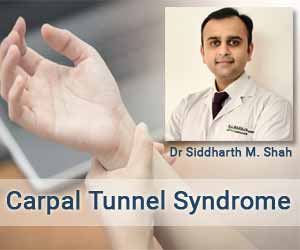- Home
- Editorial
- News
- Practice Guidelines
- Anesthesiology Guidelines
- Cancer Guidelines
- Cardiac Sciences Guidelines
- Critical Care Guidelines
- Dentistry Guidelines
- Dermatology Guidelines
- Diabetes and Endo Guidelines
- Diagnostics Guidelines
- ENT Guidelines
- Featured Practice Guidelines
- Gastroenterology Guidelines
- Geriatrics Guidelines
- Medicine Guidelines
- Nephrology Guidelines
- Neurosciences Guidelines
- Obs and Gynae Guidelines
- Ophthalmology Guidelines
- Orthopaedics Guidelines
- Paediatrics Guidelines
- Psychiatry Guidelines
- Pulmonology Guidelines
- Radiology Guidelines
- Surgery Guidelines
- Urology Guidelines
Understanding Carpal Tunnel Syndrome and its impact- Dr Siddharth M. Shah

Carpal Tunnel Syndrome (CTS) is a common condition affecting the hand. It is characterized by pain, tingling, burning, and numbness along with the thumb, index, middle and half of the ring finger; the little finger is not affected. This condition begins gradually and the symptoms are intermittent at first. Symptoms can often appear at night as many people tend to sleep with their wrists bent. If left untreated, the condition progresses resulting in frequent or persistent symptoms. In severe or advanced cases, there is wasting of muscles at the base of the thumb resulting in reduced grip strength and inability to grasp objects. It usually affects people over 30 yrs of age and is more commonly seen in females. Its prevalence is estimated to be between 1% and 5%.
WHAT CAUSES CARPAL TUNNEL SYNDROME?
It is caused due to compression of a major nerve of the hand called the Median Nerve near the wrist. It is caused due to prolonged repetitive movements of the hand and the wrist (use of mouse and keyboard), persistent use of vibrating tools, extreme positions of the wrist for long periods, heredity, wrist fractures, alcoholism, and obesity. Conditions like Rheumatoid Arthritis, Hypothyroidism, Diabetes, and pregnancy can also cause CTS.
DIAGNOSIS
Electrophysiological tests which assess nerve and muscle function can help confirm the diagnosis and also grade the severity of the problem. Additional tests like x-Rays and MRI may be required as part of the evaluation. It is important to rule out other conditions that can mimic CTS like Cervical Spondylosis with Nerve Root Impingement.
TREATMENT
In the early stages, measures like use of a wrist brace, ergonomic adjustments, avoidance or modification of activities that cause symptoms, and anti-inflammatory medications may be sufficient. Steroid injections can also help improve symptoms, but its effect is usually temporary. If conservative treatment measures fail or in severe or advanced cases, surgery to decompress the Median Nerve may be recommended.
IMPACT OF CARPAL TUNNEL SYNDROME:
Persistent or frequent symptoms can be frustrating and affect daily activities at home and work. Night-time symptoms can interfere with sleep. Treatment during the early stages can help slow or stop the progression of this condition. Surgery may be required in advanced or severe cases. If the nerve damage has become irreversible, recovery may not be complete even after surgery.
CARPAL TUNNEL SYNDROME AND SMARTPHONES:
Obsessive tapping, scrolling, and swiping on a smartphone can increase the risk of hand/wrist problems. A recent study published in the Muscle and Nerve Journal reported that - intensive users (>5 hours/day) of handheld electronic devices experienced significantly greater wrist/ hand pain. They concluded that overuse of these devices may adversely affect the Median Nerve in the Carpal Tunnel resulting in symptoms. While it is still debatable whether the overuse of smartphones results in CTS, findings of this study suggest that they should be used wisely.
DO’s and DON’Ts:
The number of patients presenting with symptoms of CTS is increasing. Also, patients are now presenting at a younger age. This may be linked to the overuse of smartphones and laptops. However, some simple do’s and don’ts can help reduce the risk of developing CTS.
1) While working on keyboards, adjust the level of the chair such that your wrist is not excessively bent in either direction
2) Take frequent breaks while performing activities requiring repetitive hand/ wrist movements
3) Avoid sleeping with your wrists bent
4) Keep your wrists straight while using smartphones try to hold your phone in both the hands while using it. Do not use a smartphone for more than 15-20 minutes at a time. Avoid marathon browsing sessions on your phone.
Dr Siddharth M. Shah is a Consultant Orthopaedics and Joint Replacement Surgeon at SL Raheja Hospital- A Fortis Associate

Disclaimer: This site is primarily intended for healthcare professionals. Any content/information on this website does not replace the advice of medical and/or health professionals and should not be construed as medical/diagnostic advice/endorsement or prescription. Use of this site is subject to our terms of use, privacy policy, advertisement policy. © 2020 Minerva Medical Treatment Pvt Ltd